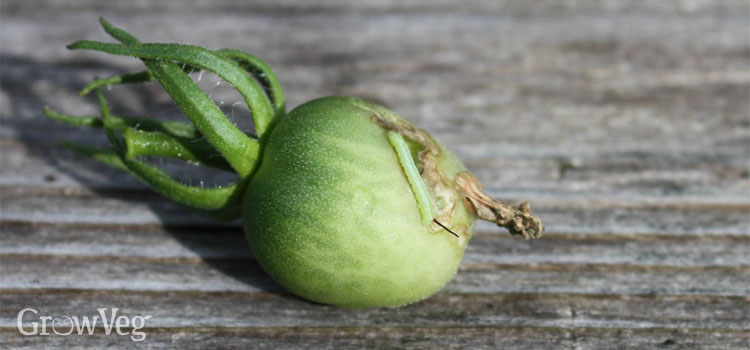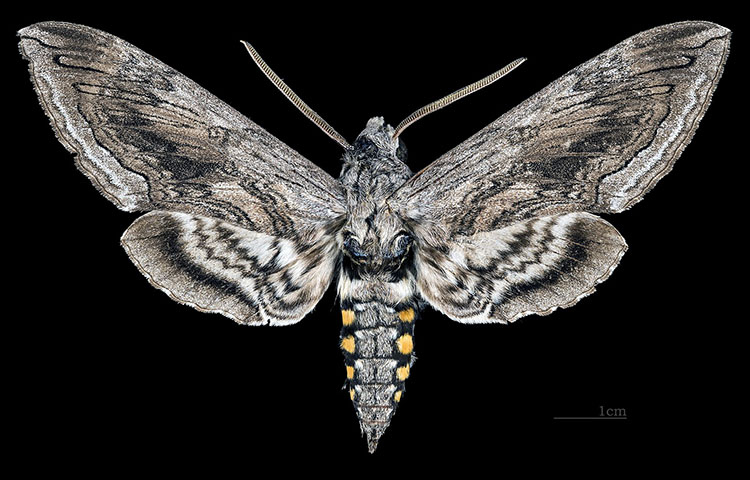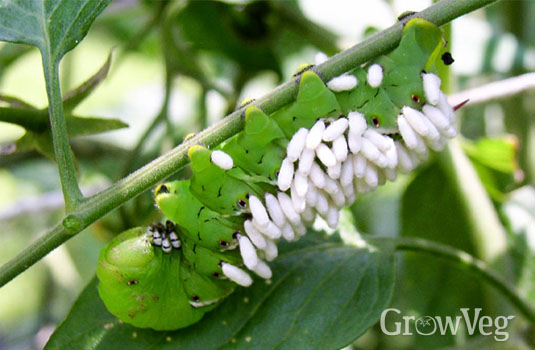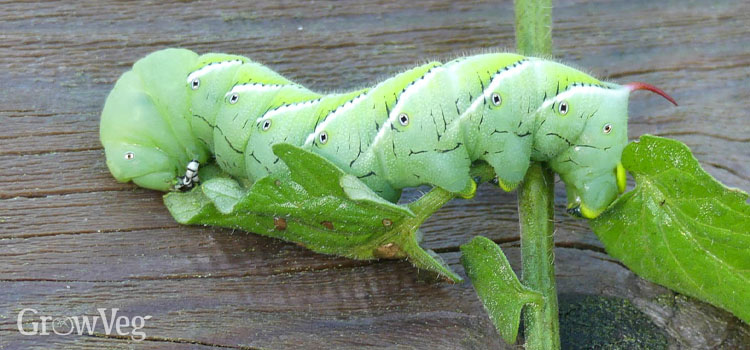Insecticide For Tomato Hornworm
The most dreaded tomato pests in both of the Americas are tomato hornworms, which become active in early summer, just as tomato plants grow to full size. First you notice part of an outer leaf missing, then a small branch eaten to a nub, or maybe your eyes land on dark green pebbles of caterpillar poo (frass). These are the signs that tomato hornworms have arrived in your garden.
In northern states, you are probably seeing true tomato hornworms (Manduca quinquemaculata), while in warmer areas tobacco hornworms (Manduca sexta) are also likely to appear. Hornworms earn their names with their fleshy ‘horns’, which they raise to frighten enemies. The horns of tomato hornworms are blue-black, while those of tobacco hornworms are reddish. Both species are native to the Americas, being larvae of two sphynx or hawk moths that fly mostly at night.
The Tomato Hornworm Life Cycle

The hornworms on your tomatoes this year may have emerged from last year’s tomato patch, or the adult moths may have flown in from afar. Either way, female moths find a promising tomato plant and scatter single light green eggs on both sides of leaves. Eggs that are not consumed by lacewings, ladybeetles or other predators hatch in about a week, and the caterpillars start eating tomato leaves and rasping surface holes in green fruits. Three to four weeks later, caterpillars not nabbed by birds, wasps or assassin bugs grow to four inches (10 cm) long before dropping to the ground to pupate. In most climates, a second generation emerges after two to three weeks.

You can use a Bacillus thuringiensis (BT) based organic insecticide to control young tomato hornworms, less than two inches (5cm) long, but more mature caterpillars may survive the treatment. Plus, more eggs are hatching all the time, which is why organic gardeners learn to be sharp tomato hornworm scouts. When you know what to look for, hand-picking tomato hornworms can be extremely effective.

Hornworm Hand-Picking Techniques
If the idea of picking up caterpillars scares you, relax. Hornworms cannot bite or sting. Their mouthparts are built for chewing soft leaves, and their fleshy horn is meant to spook enemies. Their bodies usually stay intact when plucked, so bare hands are fine for this job.
Start by checking the tops and outer branches of your largest plants for missing leaves or branch tips. Then look under the consumed foliage for a trail of dark green frass. Hornworms often feed on outer branches early in the morning and at dusk, moving to the plants’ sheltered interiors during the heat of the day. If you see hornworms every year in your garden, plan to scout for hornworms once a day. The larger hornworms grow, the easier they are to spot and remove.

Some tomato hornworms are parasitized by braconid wasps, which feed inside the hornworms and then pupate in rice-size white cocoons. Most gardeners have a live-and-let-live policy for parasitized hornworms, because the braconids will go on to help control cabbageworms, armyworms and other plant-eating caterpillars. If you have an extra tomato plant, or a volunteer sprouting from your compost, you can transfer parasitized hornworms to these non-preferred tomato plants to live out their sad lives.
Most gardeners simply squash collected tomato hornworms underfoot, or you can drown them in water. Chickens don’t care for them (they may be toxic due to concentrated solanine), but should you know a reptile hobbyist, they will be delighted to take your collected hornworms. To a lizard, one big hornworm is better than a dozen crickets.
Gain Hornworm Control with Fall Cultivation
Unfortunately, even the most conscientious gardener will never manage to rid their gardens of this pest. A few hornworms may hide long enough to change from mature caterpillar to oblong, dark brown pupae burrowed four to six inches (10-15cm) below the soil’s surface, always right beneath the tomato plants. In bad tomato hornworm years, the best thing you can do to prevent problems the next season is to pull up the plants and cultivate the soil in the fall, which exposes the brown pupae, often leading to their death. If you do a good job of it, less than 10% of the pupae will survive, which will make organic control easier next year.
Insecticide For Tomato Hornworm
Tomato worms are a common pest that can devastate tomato plants. They’re usually found in the soil, and they leave behind large burrows that make it difficult for the plants to take root.
To get rid of these pests, you’ll need an insecticide designed specifically to kill tomato worms. There are a number of different options available, so it’s important to choose one that is approved for use on tomatoes and that has been tested in gardens with similar conditions. You should also read the label carefully before buying any insecticide, as some may be harmful to other beneficial insects like bees or ladybugs.
Make sure you’re using the right amount of insecticide for your garden size and type of soil. You can also use beneficial nematodes as an alternative treatment for tomato worms if there are no other options available nearby. These tiny creatures will attack larvae as they feed on their host plants, helping you eliminate pests without using harmful chemicals!
List Of Insecticide For Tomato Hornworm
- Insect Killer: Kills listed pests, such as aphids, adult Japanese beetles, cutworms
- Fast Acting: Kills listed insects on contact
- Use On: Leafy, fruiting and root vegetables such as tomatoes, peppers, carrots, as well as on cucurbits
- Harvest Interval: Use on tomatoes up to day of harvest. See plant specific restrictions for full list
- Rainproof Protection: Rainproof in 1 hour
Additional Info :
| Item Dimensions | |
| Height | 11.25 Inches |
| Width | 2.19 Inches |
| Length | 5 Inches |
| Weight | 1.5 Pounds |
- INSECT KILLER: Kills over 70 listed insects including Aphids, Caterpillars, Thrips, Tomato Hornworm, and Whiteflies
- PROTECT FRUIT & VEGETABLES: Protect fruits and vegetables from insect damage, for outdoor use
- EASY APPLICATION: Spray onto plant until leaves are evenly coated, but not dripping
- RAINPROOF PROTECTION: Rainproof in just 1 hour
- COVERAGE AREA: Treats up tp 5,333 square feet
Additional Info :
| Color | Plum |
| Item Dimensions | |
| Height | 11.3 Inches |
| Width | 2.6 Inches |
| Length | 4.7 Inches |
| Release Date | 2011-05-23T00:00:01Z |
- CONTAINS BOTANICAL INSECTICIDES: Spray on roses, vegetables, houseplants, ornamentals, trees, shrubs and flowers right up to the day of harvest.
- KILLS ON CONTACT: Kills aphids, tomato hornworms, green fruitworms and other listed insects.
- PROTECTS YOUR WHOLE GARDEN: Use both indoors and outdoors.
- READY-TO-USE PEST CONTROL: Spray upper and lower leaf surfaces – no mixing required.
- APPLY AS NEEDED: Treat weekly or apply as needed to control infestations (up 10 to times per season).
Additional Info :
| Item Dimensions | |
| Height | 10.33 Inches |
| Width | 2.25 Inches |
| Length | 4.25 Inches |
| Weight | 3 Pounds |
- INSECT KILLER – This pest control is great for use on cabbage looper, hornworms, tent caterpillar, gypsy moth, bagworm and many more.
- PROTECTS FRUITS, VEGETABLES, SHADE TREES & ORNAMENTALS – Designed for use on broccoli, cauliflower, kale, mustard greens, eggplant, pepper, melons, tomatoes, cabbage, shade trees and ornamentals.
- DOESN’T HARM BENEFICIAL INSECTS – Kills worms and caterpillar stage insects while causing no harm to birds, earthworms, or beneficial insects, such as honeybees and ladybugs.
- FAST ACTING FORMULA – Must be eaten by worms or caterpillars to be effective. After ingesting, bugs immediately stop feeding and will die within 2-3 days.
- ORGANIC GARDENING – The active ingredient of the product is a natural strain of the bacterium Bacillus thuringiensis, which is a leading insecticide used worldwide. Approved for organic gardening, our product is safe for use around people and pets.
Additional Info :
| Item Dimensions | |
| Height | 12 Inches |
| Width | 3 Inches |
| Length | 6 Inches |
| Weight | 2.33 Pounds |
| Release Date | 2021-11-10T00:00:01Z |
- Size: 16 OZ
- Thuricide BT Caterpillar Control concentrate is used by organic gardeners and is made from bacteria that is toxic to listed pests.
- Safe to use on all plants, vegetables and edible crops.
- Very low toxicity to humans and pets.
- For large quantity discount consideration or to request a mixed multi-pack, please message us.
Additional Info :
| Item Dimensions | |
| Height | 6 Inches |
| Width | 1.75 Inches |
| Length | 4 Inches |
| Weight | 0.62 Pounds |





